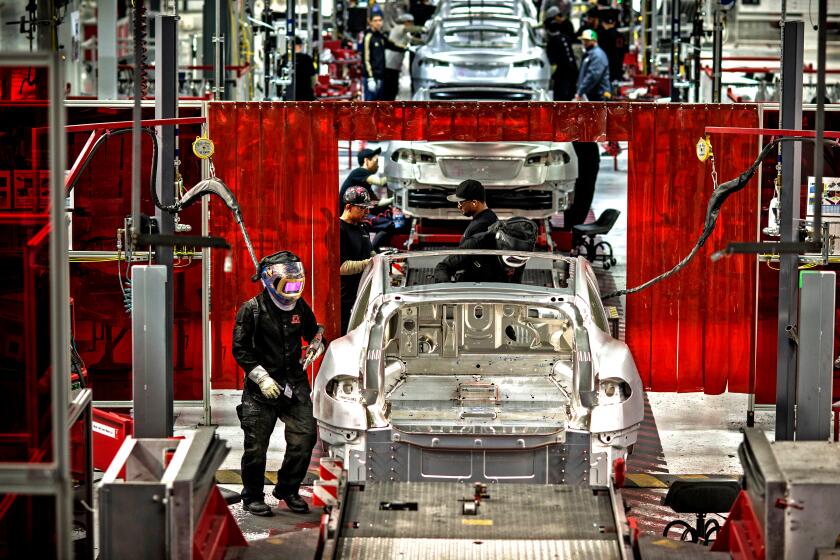Curbing Costs : Japan Car Makers Gear Up Against Industry Slump
As the shell of a new Lexus moves quietly down the production line at Toyota’s Tsutsumi plant here, the long, thin metallic arm of a robot swings toward a nearby printer. With a tiny suction cup attached, the arm picks up a computer printout describing the vehicle model and the options to be installed, and gently tapes it to the auto windshield.
The robot, which was designed and built by factory workers, shaves four seconds off the six and a half hours it takes on average to build a car here. That may not sound like much, but Toyota’s ability to continue making such small improvements has made its production system the envy of the world.
“When it comes to increasing productivity, we don’t lose to anybody,” says Masamoto Amezawa, the factory’s general manager.
Such cost-cutting skills are being tested as never before in a Japanese auto industry beset by a number of troubles: Domestic profit and sales are down because the economy is in a slump, and the strong yen has boosted manufacturing costs in dollar terms--undercutting Japan’s traditional cost advantage, particularly in the United States at the same time that the improving quality of U.S.-made vehicles is enticing more and more consumers to buy American.
But the Japanese industry is rapidly restructuring and may quickly recover. Detroit has perhaps one to two years to make the most of its current advantages, analysts say, before Japanese auto makers adjust to the new environment and rebound as even more powerful competitors.
“Just wait until the rough seas settle down again,” says Kim N.M., export marketing director at Hyundai Motor Co., who suggests Japanese companies are not pressing hard to increase foreign sales to avoid worsening trade problems with the United States. “They will come back again.”
For now, Japanese auto makers appear weak. This year--for the first time ever--the government designated car manufacturing as a troubled industry, making it eligible for subsidies from the Labor Ministry to retrain or transfer employees.
Nissan and Isuzu are losing money. Mazda expects to sink into the red this year. Toyota’s profits are down sharply and much of the money it is making comes not from selling cars, but from interest on investing the huge sums stashed away during good times.
Nissan’s decision earlier this year to close down its Zama plant--Japan’s first-ever auto plant closing--underscored the difficulties the industry faces. Other companies are trying to avoid shutting down some plants by firing temporary workers and making do with fewer shifts and less overtime.
In one attempt to adjust to the strong yen and avoid trade barriers, Japanese companies are rapidly expanding their capacity to manufacture cars offshore. Fourin Inc., a research group based in Nagoya, estimates that Japan’s overseas production capacity will climb 27% to 6.7 million cars a year between 1993 and 1997.
The biggest growth will be in Asia, where Japanese companies are expected to increase capacity 50% over the next four years. Japanese companies are also cranking up capacity in Europe.
As Japan’s auto makers become global players--manufacturing and buying parts in the markets in which they sell--they will maintain a major advantage. While Japanese companies have penetrated most foreign markets, Japan’s market, which represents 60% of all auto sales at Japanese companies, remains all but closed to outside competition. Foreign auto companies have just 2% of the market.
While poor domestic sales hurt now, the market is expected to improve near the end of the year, with Japanese auto makers virtually the only beneficiaries.
Chikao Masuzawa, an analyst at Salomon Brothers’ Tokyo office, notes that the hundreds of thousands of Japanese who bought new cars in 1990 and 1991 must soon, according to Japanese law, put their cars through an inspection process that typically costs about $1,200. If history is any guide, many owners will choose to avoid the shakken system by purchasing a new car instead.
Even if domestic sales provide a stable base for Japanese auto makers, they will still be under competitive and political pressures overseas.
If they increase overseas prices to cover their costs, they risk losing market share as has already occurred in the United States during the past year. On the other hand, if they don’t raise prices, they may find themselves selling in America at below cost and vulnerable to dumping charges.
America’s Big Three auto makers announced earlier this year that they would aggressively monitor imports for signs of dumping. Meanwhile, European auto makers earlier this year reached a deal that calls for Japan to cut its exports to Europe by 10%. And Europe is pressing for more cuts to relieve pressure on suffering European manufacturers.
Japan’s only solution is to cut costs in domestic factories and hope the political problems work themselves out.
If it fails to make domestic factories more competitive, huge overcapacity here could force Japanese auto makers and their thousands of subcontractors to undertake massive layoffs.
But if Japan succeeds, it could be American and European companies that continue to take the big hits. According to one estimate, Japan has the capacity to build about 40% of the cars sold each year in the world although its world market share is roughly 25%.
As part of cost-cutting moves, Japanese companies are increasing purchases of cheaper auto parts from the United States and other foreign suppliers. They are also reducing the number of model types and options they offer to cut expenses for parts and reduce complexity in the factory.
Toyota, for example, will reduce the number of model types by 20% and standardize more of the parts it uses. Currently, workers at Toyota’s Tsutsumu factory must choose from 70 different ceilings and 38 types of brake pedals for the two model cars they assemble.
Since parts makers produce fewer of each part, costs are higher. The costs of parts and materials at Toyota have climbed from 67% of the total cost of the car in 1986 to 76% in 1991, according to a study by Mitsubishi Research Institute.
Japan’s auto designers are looking for ways to redesign the next generation of cars so they can be built more cheaply in contrast to the over-engineered vehicles designed during the boom years of the 1980s.
While engineers and designers tackle such big cost issues, Amezawa’s team at the Toyota Tsutsumi plant are finding small and more immediate cost-cutting options.
The factory workers decided that mufflers could be made more cheaply if the manufacturer left out the glass wool used for insulation and replaced it with a heat pad on top of the muffler.
The savings? A whopping $8 per car.
Such measures are making a difference. In an average year, Amezawa’s factory will cut costs by $28 million. This year, however, Amezawa expects to cut costs by $42 million. Toyota as a whole cut expenses by $500 million in the last six months of 1992 without laying off any full-time employees.
Mazda plans to cut nearly $1 billion from its annual costs within the next three years.
Going Abroad
Japanese auto makers plan to shift much of their production overseas to avoid the problems of the rising value of the yen and export restrictions among its trading partners.
* Total overseas production capacity among Japan’s 11 auto makers is expected to increase 27% by 1997.
* 1993 Capacity, 5.2 million units 1997 Projection, 6.7 million units
* While domestic capacity is expected to shrink.
* 1993 Capacity, 16.8 million 1997 Projection, 14.1 million
* Most of the increase in overseas capacity will occur in the Asia Pacific region.
* North America
1993, 2.5 million, (47.1% of total overseas)
1997, 2.7 million, 40.2% Europe
1993, 962,000, 18%
1997, 1.4 million, 20.8% Asia-Pacific
1993, 1.5 million 28%
1997, 2.3 million 34% Other Regions
1993, 301,000, 6%
1997, 301,000, 5% Among the major auto firms only Toyota plans to increased domestic capacity as well as overseas capacity.
* TOYOTA Domestic
1993, 4.5 million units
1997 projection, 4.7 Overseas
1993, 1.2 million
1997, 1.7 million
* NISSAN Domestic
1993, 3.1 million
1997, 2.6 million Overseas
1993, 1.3 million
1997, 1.6 million
* HONDA Domestic
1993, 1.4
1997, 1.4 Overseas
1993, 792,000
1997, 817,000
* MITSUBISHI Domestic
1993, 1.4 million
1997, 1.4 million Overseas
1993, 650,000
1997, 850,000 Source: Fourin Inc.



